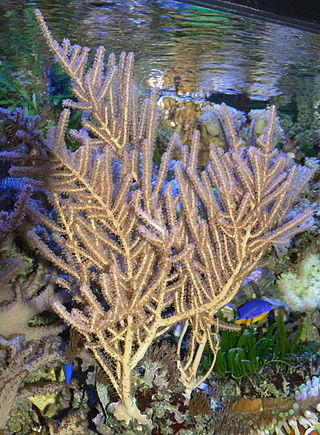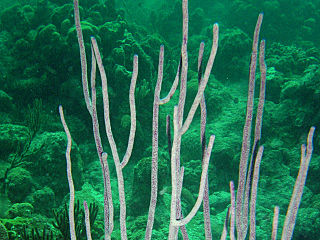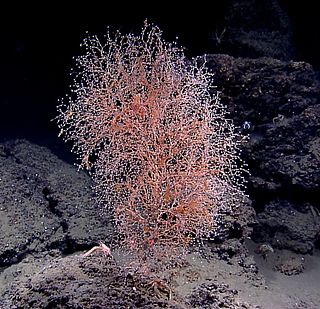
Anthia is a genus of the ground beetle family (Carabidae) from Africa and Asia. Species of Anthia can spray a jet of formic acid up to 30 centimetres (12 in), which, if not treated, can cause blindness in animals that harass the beetles.

Lamiinae, commonly called flat-faced longhorns, are a subfamily of the longhorn beetle family (Cerambycidae). The subfamily includes over 750 genera, rivaled in diversity within the family only by the subfamily Cerambycinae.

Acanella is a genus of deep sea bamboo coral of the family Isididae. Acanella are mainly studied and found in Hawaii, they are able to survive in high-flow sites and are preyed upon by nudibranch mollusks. It has a high fecundity and small size that allows high dispersal and recruitment; however, it has been classified as a vulnerable marine organism due to its vulnerability to bottom fishing gear. It contains the following species:

Keratoisis is a genus of deep-sea bamboo coral in the family Isididae, containing the following species:

Holaxonia is a suborder of soft corals, a member of the phylum Cnidaria. Members of this suborder are sometimes known as gorgonians and include the sea blades, the sea fans, the sea rods and the sea whips. These soft corals are colonial, sessile organisms and are generally tree-like in structure. They do not have a hard skeleton composed of calcium carbonate but have a firm but pliable, central axial skeleton composed of a fibrous protein called gorgonin embedded in a tissue matrix, the coenenchyme. In some genera this is permeated with a calcareous substance in the form of fused spicules. Members of this suborder are characterized by having an unspiculated axis and often a soft, chambered central core. The polyps have eight-fold symmetry and in many species, especially in the families Gorgoniidae and Plexauridae, contain symbiotic photosynthetic algae called zooxanthellae. These soft corals are popular in salt water aquaria.

Dendronephthya is a genus of soft corals in the family Nephtheidae. There are over 250 described species in this genus. They are sometimes kept in aquariums, but are notoriously difficult to keep, requiring a near constant supply of small foods such as phytoplankton.

Siphonogorgia is a genus of soft corals in the family Nidaliidae. Like other members of this family, these corals do not contain symbiotic zooxanthellae.

Anthomastus is a genus of soft corals in the family Alcyoniidae.

Ellisella, commonly known as sea whip, is a genus of soft coral in the family Ellisellidae.

Clavularia is a genus of corals in the family Clavulariidae. They are often referred by the common names star polyps or clove polyps.
Rhytisma is a genus of soft corals in the family Alcyoniidae.
Sympodium is a genus of soft corals in the family Xeniidae.

Chrysogorgia is a genus of soft corals in the family Chrysogorgiidae.
Callogorgia is a genus of deep sea corals that are ideally suited to be habitats for different organisms. They reproduce both sexually and asexually, clinging to the hard substrate of the ocean during their maturation process. Callogorgia are found at depths ranging from 750-8200 feet in the Gulf of Mexico, Pacific Ocean and the Caribbean Sea. An array of organisms have relationships with Callogorgia, including brittle stars, cat sharks, and copepods. The nature of these relationships are often commensal, with Callogorgia providing a habitat for the organisms.

John Robertson Henderson CIE FRSE FZS FLS was a Scottish zoologist who specialized in the taxonomy of marine crustaceans, particularly the decapods, and worked on specimens collected by the oceanic research vessels Investigator and Challenger. From 1892 until 1911 he was Professor of Zoology at Madras Christian College in India. From 1908 to 1920 he was Superintendent of the Government Museum in Madras. He also took an interest in numismatics and Indian history.

Paragorgia is a genus of soft coral in the family Paragorgiidae.
Villagorgia is a genus of gorgonian-type octocorals in the family Plexauridae.
Acanthomuricea is a genus of corals belonging to the family Plexauridae.

Anthogorgia is a genus of corals belonging to the family Acanthogorgiidae.
Paracis is a genus of corals belonging to the family Plexauridae.














